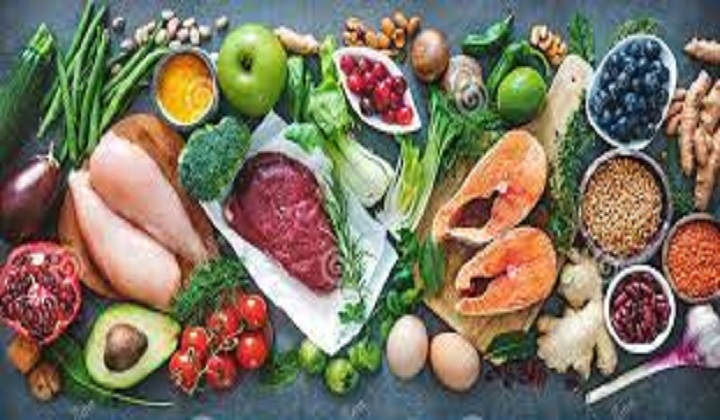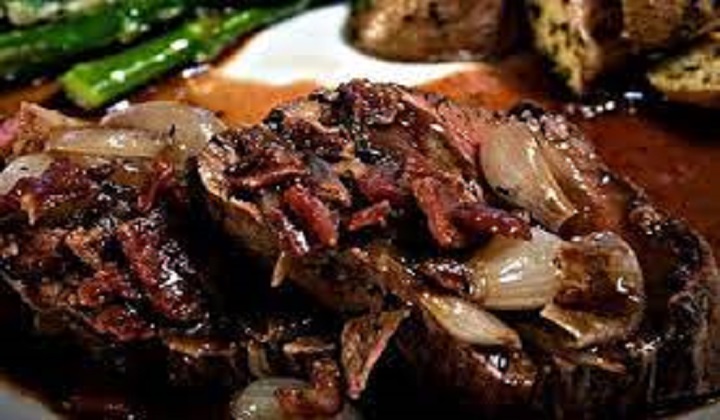Buying This Food
Fresh, red beef. The fat should be white, not yellow. Choose lean cuts of beef with as little internal marbling (streaks of fat) as possible. The leanest cuts are flank steak and round steak; rib steaks, brisket, and chuck have the most fat. USDA grading, which is determined by the maturity of the animal and marbling in the meat, is also a guide to fat content. U.S. prime has more marbling than U.S. choice, which has more marbling than U.S. good.
All are equally nutritious; the difference is how tender they are, which depends on how much fat is present. Choose the cut of meat that is right for your recipe. Generally, the cuts from the center of the animal’s back—the rib, the T-Bone, the porterhouse steaks—are the most tender. They can be cooked by dry heat—broiling, roasting, pan-frying. Cuts from around the legs, the underbelly, and the neck—the shank, the brisket, the round—contain muscles used for movement.
They must be tenderized by stewing or boiling, the long, moist cooking methods that break down the connective tissue that makes meat tough.
Storing This Food
Refrigerate raw beef immediately, carefully wrapped to prevent its drippings from contaminating other foods. Refrigeration prolongs the freshness of beef by slowing the natural multiplication of bacteria on the meat surface. Unchecked, these bacteria will convert proteins and other substances on the surface of the meat to a slimy film and change meat’s sulfur-containing amino acids methionine and cystine into smelly chemicals called mercaptans.
When the mercaptans combine with myoglobin, they produce the greenish pigment that gives spoiled meat its characteristic unpleasant appearance. Fresh ground beef, with many surfaces where bacteria can live, should be used within 24 to 48 hours. Other cuts of beef may stay fresh in the refrigerator for three to five days.
Preparing This Food
Trim the beef carefully. By judiciously cutting away all visible fat you can significantly reduce the amount of fat and cholesterol in each serving. When you are done, clean all utensils thoroughly with soap and hot water.
Wash your cutting board, wood or plastic, with hot water, soap, and a bleach-and-water solution. For ultimate safety in preventing the transfer of microorganisms from the raw meat to other foods, keep one cutting board exclusively for raw meats, fish, and poultry, and a second one for everything else. Finally, don’t forget to wash your hands.
What Happens When You Cook This Food
Cooking changes the appearance and flavor of beef, alters nutritional value, makes it safer, and extends its shelf life. Browning meat after you cook it does not “seal in the juices,” but it does change the flavor by caramelizing sugars on the surface. Because beef’s only sugars are the small amounts of glycogen in the muscles, we add sugars in marinades or basting liquids that may also contain acids (vinegar, lemon juice, wine) to break down muscle fibers and tenderize the meat. (Browning has one minor nutritional drawback.
It breaks amino acids on the surface of the meat into smaller compounds that are no longer useful proteins.) When beef is cooked, it loses water and shrinks. Its pigments, which combine with oxygen, are denatured (broken into fragments) by the heat and turn brown, the natural color of well-done meat. At the same time, the fats in the beef are oxidized.
Oxidized fats, whether formed in cooking or when the cooked meat is stored in the refrigerator, give cooked meat a characteristic warmed-over flavor. Cooking and storing meat under a blanket of antioxidants—catsup or gravy made of tomatoes, peppers, and other vitamin C-rich vegetables—reduces the oxidation of fats and the intensity of warmed-over flavor. Meat reheated in a microwave oven also has less warmed-over flavor.
An obvious nutritional benefit of cooking is the fact that heat lowers the fat content of beef by liquifying the fat so it can run off the meat. One concrete example of how well this works comes from a comparison of the fat content in regular and extra-lean ground beef. According to research at the University of Missouri in 1985, both kinds of beef lose mass when cooked, but lean beef loses water and regular beef loses fat and cholesterol.
Thus, while regular raw ground beef has about three times as much fat (by weight) as raw ground extra-lean beef, their fat varies by only 5 percent after broiling. To reduce the amount of fat in ground beef, heat the beef in a pan until it browns. Then put the beef in a colander, and pour one cup of warm water over the beef.
Repeat with the second cup of warm water to rinse away fat melted by heating the beef. Use the ground beef in sauce and other dishes that do not require it to hold together
 Tech Readers
Tech Readers




